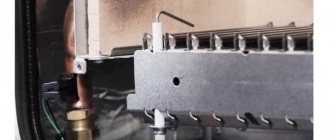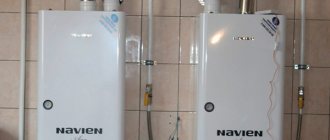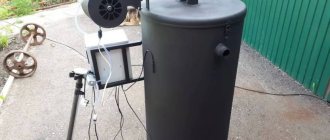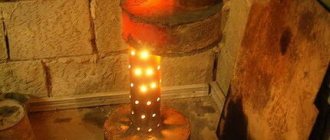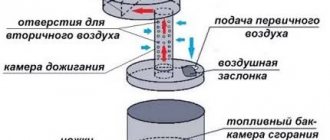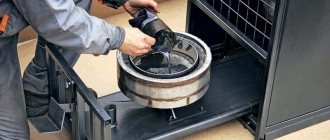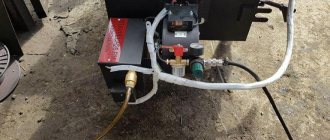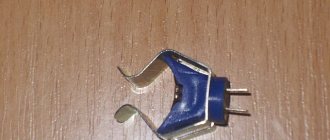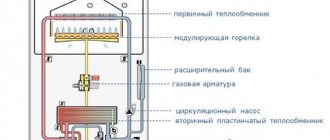In modern industries that use petroleum-oil materials, the percentage of waste can vary widely, sometimes requiring the involvement of third-party organizations for the disposal of waste products. In turn, liquid fuel boilers are today experiencing another stage of development, offering the consumer a lot of new technological opportunities. The use of economical fuel based on industrial waste just adds to the attractiveness of this equipment on the market. However, heating boilers using waste oil have certain technical and operational features that can also be considered as weak points. In any case, before choosing such a unit, a detailed analysis of all technical, functional and economic aspects of its application is required.
General information about boilers for “working out”
The concept of recycling spent fuel materials has existed almost since the problem of disposal of oil-containing waste arose. However, in boiler equipment this approach has gained full life only recently - since large manufacturers have mastered pyrolysis technologies and long-term combustion systems. These developments most likely relate to the recycling of gas mixtures from solid fuels, but their principles can also be transferred to the concept of waste oil boilers. For oil, in this case, a special burner is used, connected to an inversion combustion chamber and a smoke pipe.
Of course, the main point of difference between this equipment and classic liquid fuel units is the fuel raw materials used. There is still a certain segmentation by the type of technological development products used, but the future of such models lies in universalization from the point of view of fuel supply. One way or another, waste oil boilers for homes primarily operate using kerosene, diesel fuel and other diesel derivatives. Some modifications also support combustion when fueled with vegetable oils and special heating oil. In the case of industrial models, we may be talking about the use of coarse heterogeneous compositions with impurities.
Principle of operation
In essence, a traditional solid fuel boiler works like a regular stove. There is also a firebox in which wood (coal, pellets and other types of solid fuel) burns. The released energy heats the coolant located in a container above the combustion chamber.
The coolant in this design is heated both from the internal pancake and from the chimney, which penetrates through the container with water. At the same time, the boiler body also heats up, which creates an accumulating effect that inhibits rapid cooling when the unit is turned off.
The heated coolant rises up and exits through the upper pipe into the supply circuit of the heating system. The cooled coolant enters the boiler through the lower pipe connected to the return circuit.
Structural device of the unit
The main material for the manufacture of this type of liquid fuel boiler is metal - cast iron, steel and individual elements from other alloys. The structure is formed by the following parts:
- Frame.
- Protective casing.
- The combustion chamber.
- Case cover.
- Fuel tank.
- Fuel line.
- Pump to ensure fuel supply.
- Burner.
- Divider.
- Bowl.
- Control panel with automation unit.
- Overflow glass.
- Damper.
In the above drawing of a waste oil boiler, you can also notice the presence of a fan to supply oxygen to the burner. This solution is rather optional, but it provides a fundamentally important opportunity to regulate the intensity of combustion. Theoretically, it is also possible to convert the generated thermal energy into current, which can be used to ensure the autonomous operating process of the equipment. However, the technical implementation of this function does not justify itself in practice for a number of reasons. On the other hand, power supply from a standard 220 V power supply does not burden the user much in terms of financial costs, since energy is required only for low-power control electronics, and not for generating heat. By the way, the thermal power of such boilers is on average 10-25 kW, which corresponds to the average performance of industrial heating equipment. The efficiency reaches 75%, which is also not bad, although gas pyrolysis units in modern modifications reach 95%.
Operating principle of the boiler
At the moment the equipment starts up, a fan begins operating through the control panel, directing air flows into the combustion chamber. At the same time, the burner is automatically ignited. Full operation of the pump in a heating boiler using waste oil begins after 30-40 minutes, when the housing warms up. When the temperature sensor reaches the required values, it sends a signal to start the fuel line. Next, from the heated bowl with the tank, the supply of oil to the burner begins.
It should be noted that in different boilers the fuel supply is organized in several ways. In the simplest version, the oil is supplied in its pure form without auxiliary additives. This simplifies both the design of the unit and its technological processes. But in more developed models, the fuel delivery channel has a number of technological points at which the liquid is filtered and enriched with air from the fan. At the final stage of the functional cycle of a heating boiler, the mixture burns using waste oil, and the combustion products are discharged through the chimney to the street. After the burner function is completely turned off, the fan should continue to run for some time to cool the boiler walls and remove any remaining fumes.
Making a boiler with your own hands
Any solid fuel or gas stove can be converted to use liquid fuel. But for self-production, it is better to choose a drawing of an exhaust boiler with a water circuit with a flame bowl.
The homemade boiler is small in size, but still provides 15 kW of thermal power. It consumes no more than 1.5 liters of waste per hour. Air is pumped into the combustion chamber using a small turbine, so you will need to take care of supplying electricity to the unit. Fuel enters the combustion zone in portions from a separate tank equipped with a valve. The latter can serve as a heating regulator.
To improve afterburning, the central pipe has a large number of holes and horizontal slots. Smoke from fuel combustion escapes through a chimney fixed at the exit of the combustion chamber.
Required tools and materials
It is necessary to prepare in advance the container from which the body will be made. A gas cylinder is best suited for this. You need to choose a copy with a volume of 50 liters or more.
You will also need the following materials:
- Steel pipe Ø 100 mm with a wall thickness of at least 2 mm. It is needed for the chimney.
- Metal sheet half a centimeter. With its help, the combustion chamber will be separated from the evaporation zone.
- Iron pipe Ø 100 mm with a wall thickness of 6 mm. It will be used to make a burner.
- Brake disc from a car. Its diameter must be at least 20 cm.
- Coupling for connecting pipes.
- Half inch ball valve
- Fuel hose.
- Fuel storage tank.
- Blanks for legs.
- Pipes.
After assembling the device, it will need to be protected from corrosion. To do this, you should additionally purchase the necessary chemicals and enamel.
As for tools, first of all you will need a welding machine. It is best to use an inverter, as it allows you to make high-quality welds. Also useful: drill, angle grinder with a set of discs, drills, thread dies, wrenches, electric emery.
You will have to work with metal a lot. To speed up work, you need to prepare a container of water to quickly cool the tools.
Assembly order
Before starting to work with the cylinder, it must be completely emptied of gas residues. This is done by simply turning off the valve and turning the container over to remove condensate. After washing the cylinder, you can begin assembling the boiler:
- 2 openings are cut in the cylinder, one above the other. A jumper 50 mm wide is left between them. The upper window is 2 times larger than the lower one.
- Hinges and latches are welded to the edges of the pieces remaining after cutting out the openings. These will be the doors of the openings.
- A disk is cut out from a sheet of metal 5 mm thick to the diameter of the cylinder. A hole is made in the center of the resulting part for a Ø 100 mm pipe. The disc is adjusted to its location in the cylinder.
- A piece of pipe with thick walls 200 mm long is cut. Holes Ø12 mm are drilled into it in increments of no more than 40 mm. Moreover, perforation should occupy only half of the workpiece.
- A previously prepared disk is welded in the center of the resulting burner. It should be placed above the holes.
Create your own cauldron
- The partition with the burner is inserted into the cylinder and welded to the partition between the openings.
- The evaporator bowl is assembled from the brake disc. The holes in it are welded using a metal disk.
- A lid is made for the bowl with a hole for the burner. A steel pipe coupling is welded to its edges.
- The body of the water jacket is welded from two sheets of metal around the cylinder. Holes are cut in the upper and lower parts of the casing for subsequent fastening of the water supply and drainage pipes.
- The top of the almost finished boiler is closed with a lid with an embedded chimney pipe.
- A fuel tube is cut into the side wall of the cylinder at the level of the lower chamber. Its tip should be located exactly above the fuel supply window into the bowl.
- The fuel tank is attached through a ball valve.
After completing the assembly work, you need to check the functionality of the unit. It is better to do this before installing it in the heating system. To check, used oil is poured into the lower firebox through a ball valve. A little kerosene is added on top and set on fire. If everything is fine, then you can connect the boiler to the heating system.
Features of hot water models
Double-circuit boiler equipment today is widely used in individual home heating and water supply systems. One circuit serves heating needs, and the second circuit organizes hot water supply. What are the features of a boiler with a water circuit using waste oil? In this design, the unit combines the design differences of indirect heating boilers and standard equipment for burning waste oils. In particular, the design is complemented by the following functional components:
- Fuel heater. Before being sent to the block with the nozzle, the oil is heated to the optimal combustion temperature. This preparation is necessary to maintain stable combustion of the liquid.
- Storage tank. A buffer tank (receiver) for containing constantly or periodically heated water. The volume of the tank in a waste oil heating water boiler can be 30-80 liters, if we are talking about household class equipment.
- Heat exchanger. This component is present in all boilers. It is where the water heating processes for servicing the hot water system take place. The type of power supply to the heat exchanger is fundamentally important - either through third-party boiler equipment, or using a built-in heating element powered from the same 220 V network.
In addition, the design of a boiler with a water circuit using waste oil sometimes contains less significant design features:
- Reusable fuel filter - for working with low quality oils.
- Water cooling for the heat exchanger is required to prevent the formation of burnout points and scale.
- Aquastat is an additional boiler control element in the water circuit.
Assembling a homemade heating device
The boiler can be made in various shapes depending on the wishes of the owner. As a rule, it is made round and rectangular.
In order to begin assembly, you should prepare the necessary materials and tools for the work. Their standard list looks like this:
- steel sheets whose thickness is more than 4 mm;
- air duct pipe;
- pieces of reinforcement (4 pcs.);
- pump and compressor;
- expansion tank;
- welding tools;
- asbestos sheet.
Since the boiler can be of different configurations, instead of the main material, you can use improvised means, for example, a cylinder or a thick-walled pipe of sufficiently large diameter.
Manufacturing of the boiler body
To assemble the boiler body, you first need to take a pipe of the largest diameter and cut it on both sides to obtain a cylinder, the length of which should be no more than 1 m. The same cylindrical shape is made from a pipe of a smaller cross-section, but 20 cm high.
After that, holes are cut out in the plates, in which the diameter of one should be equal to 20 cm, and the second - in accordance with the dimensions of the chimney. Then a cylinder of larger diameter is welded on both sides with pre-prepared plates so that a 20-centimeter hole is made from the bottom.
A cylinder of smaller diameter is built into it and welded. The bottom of the pipe should also be covered with a plate and fixed by welding. Then reinforcement legs are attached to the body, and ventilation holes are also drilled. After that, a chimney is installed on top of the cylindrical device, and a door is cut out in the lower part using a grinder.
This housing has the simplest configuration, but even a water circuit can be connected to it. To do this, a fuel supply container, a pump and an air compressor are additionally connected. At the same time, a circuit is also drawn to ensure water circulation.
Burner installation
To ensure uniform heating of the water in the boiler for a device with a dual-circuit system, it is necessary to install a reliable burner.
A ready-made burner can be purchased in a store or ordered from a specialist, but you can also make it yourself using a specific scheme.
Preparing the site for installing the system and exhausting the chimney
The assembled parts of a heating device operating during mining are usually installed in the corner of the building. Since the boiler heats up very quickly, the floor and walls should be prepared for this.
In the place where the system will stand, it is necessary to make a concrete screed or cover it with ceramic tiles. The walls adjacent to the device should not be made of flammable materials.
After the housing of the heating system is fixed in the selected location, it is necessary to begin installing the chimney. As a rule, it is made at least 4 m long.
In the section of the ceiling covering where the pipe goes outside, a heat-resistant casing is installed, the function of which can be performed by several layers of asbestos. To ensure draft regulation, the chimney is equipped with a metal damper.
How to connect the water circuit?
DIY waste oil boiler drawings.
In order to install a water circuit on a structure operating in mining with your own hands, you will first need to install a pipeline and batteries, which are connected to each other and fixed around the perimeter of the room along the walls. Then you need to select a water container and securely attach it to the boiler body using bolts or welding.
A hole is cut out of the top of the container and a pipe is welded to supply heated liquid to the system. Another pipe is attached to the bottom of the circuit so that the cooled water returns to the boiler.
Do-it-yourself heating system is a convenient and simple design not only during installation, but also during use. By installing this equipment, you can spend more time in the garage, even in severe frosts.
Boiler fuel system
The fuel supply line, as already mentioned, can be organized according to different schemes. This does not have to be an integrated infrastructure - at least, starting from the connection point to the point of collection. In other words, a container with permanent storage of fuel material can be organized in a completely different room in a place safe from fire. In this case, the main thing is to organize a pumping system of sufficient power. Also, according to the rules for operating a heating boiler using waste oil, fuel must be taken from the bottom of the tank at a level not lower than 150 mm from the bottom. This is important to protect communications from contamination by impurities and sediment that accumulates at the bottom.
As for the pumping system, its basis is formed by a pump. It is important to keep in mind that even boiler circulation pumps are not suitable in this case. Due to the specifics of the liquid being serviced, only special industrial models for technical mixtures can be used. The same applies to the pipeline with hoses and connecting and transition fittings. Like conventional water supply and heating networks using a liquid coolant, boilers operating on waste oil are not immune to airing of the fuel mixture supply line. Moreover, in such systems, the presence of air can result not just in a decrease in performance with thermal power, but also in a serious accident with damage to the combustion chamber. Therefore, an air vent valve - manual or automatic - should be attached to the fuel line process unit.
Case manufacturing
So, first of all, the details of the future unit are prepared. The body of the heating device will be made from a 425 mm pipe. For a small heating boiler, a height of 1.0-1.2 m, taking into account the small diameter, is the best option.
We cut the pipe to these dimensions using a gas cutter. We process the edges with a grinder.
Openings for firebox and ash pan
Now you need to cut two holes in the body: for the firebox and for the blower. They should be rectangular. A size of 20x10 cm is suitable for the firebox, 20x3 cm for the blower. They are located one above the other, the firebox hole is higher.
The distance from the edge of the pipe to the blower is within 5-7 cm. The distance between the holes is 5 cm. The edges of the hole are processed with a grinder. A cut piece of the firebox pipe wall will be used as a door. Its edges are also cleaned.
Holes for pipes
Using a cutter, two more holes are cut for the supply and return pipes with a diameter of 25 mm. The holes are located opposite each other. In this case, the return hole is cut out on the side of the boiler above the firebox: from the firebox hole at a distance of 15 cm.
At a distance of 5 cm only from the upper edge of the housing, a hole is cut to supply coolant. Two bends can be welded to these holes right there.
Waste oil boiler burner
One of the most important devices of the unit, directly involved in the process of burning the fuel mixture. The burner must be compatible in size and design with the fuel pump, as well as the filter and heater, if equipped. Included with this device may be:
- Pressure gauge for measuring pressure in the fuel line.
- Vacuum gauge.
- Mounting fuel intake fittings.
- Separator for additional purification of incoming oil.
Structural mounting of the burner for waste oil boilers is usually performed on the flange of the front door of the equipment using a special gasket. Next, a heater and other functional accessories like the same filter are mounted. At the same stage, an electrical power supply circuit is laid to the heater. Moreover, it does not have to be connected to 220 V. In some models, 12 V is sufficient, that is, you can limit yourself to battery power supply. As for the connection to the fuel line, it is most often done through a fitting to the burner valve. A thin 1/4" hose is used for the liner.
The best known manufacturers and models: characteristics and prices
One of the best Finnish-made boilers for heating a private house. In addition to the 35.6 kW version, there are also other versions with a heating capacity of 60-220 kW. It is distinguished by high reliability, a well-thought-out system to simplify maintenance and cleaning (for example, an increased diameter of the firebox and smoke pipes, a vertical chimney, so that soot pours into the ash pan, a door that opens with the burner, so access to the combustion chamber is achieved by pressing the handle).
The boiler is also known for its compact size, functional automation with the ability to connect a GSM module and one of the highest efficiency for this type of boiler - 88%. Fuel consumption at maximum load is 3.3 l/h. The model has all the necessary protective functions and modes, the ability to connect a room thermostat and external temperature sensors.
The only known disadvantages are noisy operation, the absence of a fuel pump, heavy weight (157 kg) and an unreasonably high price. Country of origin: Finland.
Model from a Russian manufacturer with a power of 40 kW. In terms of design and principle of operation, it does not differ from the above-mentioned Finnish analogue, it is equipped with the same heat exchanger made of heat-resistant steel, is less convenient to maintain, inferior in quality of materials and assembly, has larger dimensions and less functional controls.
However, it also has significant advantages in the form of a much lower cost, a full-fledged fuel unit (pump, filters, tank) included with the boiler, and the ability to operate on a large number of fuels (fuel oil, crude oil, heating oil).
Vertical drip type model made in Russia with a power of 15 kW. The distinctive features of the model are its extremely low cost, compact size, reliability and the presence of an oil pump included. In addition to mining, it is capable of burning kerosene. The model is equipped with one of the best automatic control units in the drip oil boiler segment, but the automation is still inferior to standard models that spray fuel.
Also known disadvantages are the need for daily cleaning and domestic build quality. According to installation practice and owner reviews, in all cases the model has been working without problems for more than 7 years.
Cost : 36,800-39,900 rubles.
Another domestic drip-type model with a power of 28 kW. The boiler has the same design and operating principle as EcoBoil, but has a higher cost with less functional automation. The advantage is the removable pyrolysis bowl (in which the oil evaporates), this makes it easier to clean, and in case of burnout it can be easily replaced.
Cost : 44,500-50,000 rubles.
Communication means for boiler piping
The main work related to connecting the boiler itself consists of organizing hydraulic connections. At a minimum, pipes for supplying oxygen must be prepared (closed circuit system), and in the case of using dual-circuit hot water models, piping for the heat exchanger must be performed. If a full-fledged hot water system is being organized, then it would not be superfluous to introduce a controlled multifunctional collector into the infrastructure, from which it will be possible to control the temperature on different water supply lines - for example, circuits to the sink in the kitchen, bathroom, bathroom, etc. On the other hand, a waste oil heating boiler must be connected to wastewater discharge channels. Although there is no talk of water consumption at the level of the storage tank with the heating system, the heat exchanger can be flushed periodically, after which the used liquid is sent to the sewer. In terms of electrical connections, an insulated wiring circuit is organized, which includes a safety block, a short-circuit protection system, a stabilizer and grounding.
Homemade waste oil boilers
The design of such a unit can be assembled with your own hands, using special equipment and accessories that are also found in ordinary private households. The base will be assembled on metal housings, which will be required to contain the waste oil and combustion chamber. All connections to the combustion chamber are made using metal pipes - to the oil container and the chimney. The most difficult thing that you will need to implement with your own hands in a heating boiler using waste oil is an automatic circulation system. To do this, it is better to use a submersible circulating oil pump. It is installed in a fuel container and pumps flammable liquid into the combustion chamber. The intensity of the oil supply will be controlled by a flow meter installed in the evaporation chamber, where the oil is pre-conditioned. A fan with oxygen injection is also connected to the combustion chamber to maintain stable combustion.
Features of burner manufacturing
Made with your own hands, it should have a small size, and in appearance it will resemble a gas cylinder. Pipe sections made of metal are fixed to the body at the top and bottom. They must be strengthened by welding, and positioned opposite to each other. The lower section is needed in order to supply the oil-oxygen suspension to the compartment where combustion takes place. The upper section is used as a burner flare. A torch of flame with a significant temperature erupts from it. In order to ensure air flow into the structure for the formation of a flame, a household vacuum cleaner is used; it is necessary to use one that has significant power.
Equipment advantages
The strengths of operating boilers during “working out” include the following:
- Economical. The main factor in favor of using this equipment. Gas is considered the cheapest fuel material, but this system can compete with it. Another thing is that the initial price of waste oil boilers is 15-20% higher than conventional liquid fuel models, averaging 70-100 thousand rubles.
- Autonomy. The system does not depend on local utility lines. If there is no supply line for the same gas, then it makes sense to organize the delivery of used oil from the nearest recycling point or service station. Some enterprises are ready to give away “work off” for free, so logistically this scheme is completely justified.
- Efficiency. Liquid fuel boilers as such today are inferior to their gas and solid fuel counterparts in a number of criteria, but they have a big advantage in the form of high rates of warming up and heat transfer.
Advantages and disadvantages
The main advantage due to which the homemade burner at the Babington mine has gained wide popularity is its omnivorous nature, as mentioned above. In fact, you can pour any heated oil of a reasonable degree of contamination onto a spherical surface, and a properly made burner will still operate stably. It is not afraid of gasoline or antifreeze impurities, unless their ratio with oil is one to one, then problems will inevitably arise. And then, this is not at all a reason to get rid of such a mixture; for the burner to function normally using waste oil, it will need to be well diluted with the “correct” treatment, and then put into use.
Another advantage is the simplicity of the design, which is why craftsmen quickly mastered this product. Indeed, making the “heart” of the device from a ball or hemisphere placed in a body is quite simple. It is somewhat more difficult to organize the fuel supply and air injection, and even to configure the entire system so that the DIY Babington burner operates stably and safely. But there is wide scope for the implementation of various technical solutions.
Of the serious shortcomings of the unit, only one is striking. This is the constant presence of dirt in the room where the liquid fuel burner operates. Unfortunately, it is impossible to completely eliminate accidental spills or seepage of contaminated machine oil through leaks, even if all connections are sealed and an automatic Babington burner is installed. To one degree or another, the room will be dirty, you will have to come to terms with it.
Due to its popularity and simplicity, the burner for the waste boiler is made by craftsmen in different variations, but we will undertake to describe the simplest design, which will be available for repetition at home. First you need to select the necessary materials, here is their list:
- Steel tee with internal threads with a diameter of 50 mm - for the body.
- Squeegee with external thread with a diameter of 50 mm - for the nozzle. Its length is optional, but not less than 100 mm for the nozzle.
- Metal elbow DN10 with external threads - for connecting the fuel line.
- Copper tube DU10 of the required length, but not less than 1 m - to the fuel line.
- A metal ball or hemisphere that fits freely into the tee is for the working part.
- A steel tube of at least DN10 is used to connect the air duct.
To make a burner for testing with your own hands, you need to perform one precise operation - make a hole in the center of the sphere. The hole diameter is from 0.1 to 0.4 mm, ideally 0.25 mm. It can be done in 2 ways: drill with a tool of the appropriate diameter or install a ready-made jet at 0.25 mm.
It is not easy to accurately make such a small hole; thin drills easily break. Instructions on how to do this correctly are shown below:
Another way to make a calibrated hole in the spherical part of an autonomous burner is to insert a nozzle of the required diameter there. To do this, a hole is drilled, the diameter of which is slightly less than the outer diameter of the nozzle, and processed with a reamer. The jet is pressed inside and polished, as described in the video:
When this operation is completed, we assemble the burner based on the drawing:
A hole must be made on the side of the nozzle wide enough to ignite the unit. A large fuel heating spiral is not needed, 2-3 turns are enough. The finished product can be mounted on a mounting plate and built into any boiler, including a homemade one. At the end of the work, you need to connect the air and fuel lines, and then organize the supply of oil and air. The simplest method of fuel supply is by gravity; for this purpose, the waste container is suspended from the wall above the burner device and a tube is laid from it.
If you use a pump to pump oil, you can subsequently use control sensors and a control unit, then you will have an automatic burner that will be safer to operate. Detailed instructions for selecting materials and assembling the device are shown in the video:
If everything is done correctly and the diameter of the air hole is 0.25 mm, then the fuel consumption of the burner should not exceed 1 liter per hour. There should be no black soot during combustion; you need to achieve even burning of the torch. The adjustment is carried out by moving the sphere back and forth or changing the air pressure. Any compressor can cope with its injection, even from a refrigerator, since the operating pressure does not exceed 4 Bar.
Equipment disadvantages
Unfortunately, the positive aspects of using this equipment can be overshadowed by one significant drawback. It lies in the high maintenance requirements of the unit. Wood-burning fireboxes are considered the dirtiest and most troublesome in terms of maintenance, but recycled materials from oil refining can cause even more problems in this regard. The fact is that waste oil boiler oil contains persistent impurities that accumulate on the walls of the combustion chamber. Even in industry, highly specialized equipment is used for subsequent cleaning, and in domestic conditions, only daily maintenance of the equipment will help eliminate the need for a painstaking fight against stagnant deposits.
Advantages and disadvantages of a do-it-yourself burner
Each technical device has a number of useful qualities and shortcomings. Obviously, this device has more pros than cons. The main advantage is the utilization of waste raw materials for the greatest benefit. Other advantages of oil and liquid fuel recycling equipment:
- burning waste helps preserve the environment;
- ease of operation and high energy efficiency;
- manufacturing of the device is possible under normal household conditions;
- obtaining heat at a minimum cost of raw materials;
- simple design manufacturing scheme, clear drawings;
- a homemade apparatus can be made from available materials;
- use in workshops and enterprises where a lot of processed raw materials accumulate that require disposal;
- the small dimensions of the burner allow it to be moved if necessary;
- waste and the lowest-grade oil go into the furnace;
- device functionality;
- relative fire safety;
- reuse of used oil.
The main advantage of the burner is the beneficial disposal of used oil
Flaws:
- It is not recommended for use in cottages and residential premises due to burning and odor;
- the need to equip the premises with a fire extinguisher;
- It is imperative to follow all recommendations for the manufacture of the burner;
- the nozzle or nozzle should be checked periodically (if the holes are clogged with solid particles);
- sensitivity of the nozzle or nozzle to contamination;
- additional power supply to the components of the device (pump, compressor).
Difficulties of self-production
Hemispheres (balls) for a Babington burner can only be made independently by a highly qualified turner. It is problematic to drill holes of 0.35 mm - for approximately 35 kW of power. Or a smaller diameter of 0.25 mm - by 20 - 25 kW. Or a couple of holes are made - for 70 kW, for example. But the main thing is the alignment of this hole and the direction of the burner, otherwise...
How to make a ball (sphere) for an oil burner can be seen in this video.
In the future, this key detail is framed by all the necessary “who knows what”. To equip the burner, a crosspiece of pipes, sections of pipes, a copper pipe for supplying fuel wrapping around the burner is used, from which it is supplied to the pressure stabilizer…. The simplest additional equipment is an air compressor with a storage tank (stabilized pressure is required), a barrel installed higher for fuel so that it flows by gravity, and the same barrel under the burner where the remains go. You can see one example of such a design...
Reviews from boiler owners
The practice of using such boilers rather reflects positive operating experience. Many users note the organizational ease of servicing equipment, which is associated with the absence of oil delivery problems and economic benefits. Despite the skepticism of many private homeowners in principle regarding the use of recycled oil as an energy source, reviews of waste oil boilers show that during operation, relatively clean mixtures pollute the chimney with the combustion chamber less than solid fuel units. That is, it all depends on the characteristics of the oil used, but the very possibility of using a huge list of liquid fuel materials is undoubtedly a plus for such boilers.
Boiler installation
First of all, when installing the boiler, fire safety measures must be observed. Care should be taken in advance to ensure its safe operation.
- A chimney is required to remove combustion products.
- The ceiling should be protected from heat, so a casing should be provided for the boiler.
- You need to think about a special damper that will block the draft. The damper will also protect against excessive cooling when the boiler is idle.
- A homemade boiler involves burning oxygen, so you need to ensure the room is ventilated.
- It is advisable to install the boiler on a heat-resistant tile or stone. It cannot be covered with wood panels or plastic lining, but it can be painted with heat-resistant paint.
- It is necessary to provide free access to the boiler, because it will be necessary to constantly add waste. The boiler heats up during operation, so flammable objects should not be placed near it. For the same reason, you should not touch it with open hands - you may get burned.
Do not forget that negligence or an error in installation can cause serious consequences, since such a boiler is potentially dangerous. Therefore, work should be performed very carefully.

